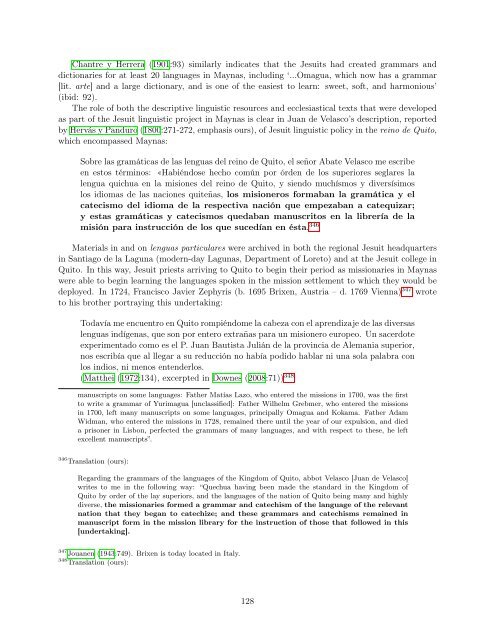draft manuscript - Linguistics - University of California, Berkeley
draft manuscript - Linguistics - University of California, Berkeley
draft manuscript - Linguistics - University of California, Berkeley
Create successful ePaper yourself
Turn your PDF publications into a flip-book with our unique Google optimized e-Paper software.
Chantre y Herrera (1901:93) similarly indicates that the Jesuits had created grammars and<br />
dictionaries for at least 20 languages in Maynas, including ‘...Omagua, which now has a grammar<br />
[lit. arte] and a large dictionary, and is one <strong>of</strong> the easiest to learn: sweet, s<strong>of</strong>t, and harmonious’<br />
(ibid: 92).<br />
The role <strong>of</strong> both the descriptive linguistic resources and ecclesiastical texts that were developed<br />
as part <strong>of</strong> the Jesuit linguistic project in Maynas is clear in Juan de Velasco’s description, reported<br />
by Hervás y Panduro (1800:271-272, emphasis ours), <strong>of</strong> Jesuit linguistic policy in the reino de Quito,<br />
which encompassed Maynas:<br />
Sobre las gramáticas de las lenguas del reino de Quito, el señor Abate Velasco me escribe<br />
en estos términos: «Habiéndose hecho común por órden de los superiores seglares la<br />
lengua quichua en la misiones del reino de Quito, y siendo muchísmos y diversísimos<br />
los idiomas de las naciones quiteñas, los misioneros formaban la gramática y el<br />
catecismo del idioma de la respectiva nación que empezaban a catequizar;<br />
y estas gramáticas y catecismos quedaban manuscritos en la librería de la<br />
misión para instrucción de los que sucedían en ésta. 346<br />
Materials in and on lenguas particulares were archived in both the regional Jesuit headquarters<br />
in Santiago de la Laguna (modern-day Lagunas, Department <strong>of</strong> Loreto) and at the Jesuit college in<br />
Quito. In this way, Jesuit priests arriving to Quito to begin their period as missionaries in Maynas<br />
were able to begin learning the languages spoken in the mission settlement to which they would be<br />
deployed. In 1724, Francisco Javier Zephyris (b. 1695 Brixen, Austria – d. 1769 Vienna) 347 wrote<br />
to his brother portraying this undertaking:<br />
Todavía me encuentro en Quito rompiéndome la cabeza con el aprendizaje de las diversas<br />
lenguas indígenas, que son por entero extrañas para un misionero europeo. Un sacerdote<br />
experimentado como es el P. Juan Bautista Julián de la provincia de Alemania superior,<br />
nos escribía que al llegar a su reducción no había podido hablar ni una sola palabra con<br />
los indios, ni menos entenderlos.<br />
(Matthei (1972:134), excerpted in Downes (2008:71)) 348<br />
<strong>manuscript</strong>s on some languages: Father Matías Lazo, who entered the missions in 1700, was the first<br />
to write a grammar <strong>of</strong> Yurimagua [unclassified]: Father Wilhelm Grebmer, who entered the missions<br />
in 1700, left many <strong>manuscript</strong>s on some languages, principally Omagua and Kokama. Father Adam<br />
Widman, who entered the missions in 1728, remained there until the year <strong>of</strong> our expulsion, and died<br />
a prisoner in Lisbon, perfected the grammars <strong>of</strong> many languages, and with respect to these, he left<br />
excellent <strong>manuscript</strong>s”.<br />
346 Translation (ours):<br />
Regarding the grammars <strong>of</strong> the languages <strong>of</strong> the Kingdom <strong>of</strong> Quito, abbot Velasco [Juan de Velasco]<br />
writes to me in the following way: “Quechua having been made the standard in the Kingdom <strong>of</strong><br />
Quito by order <strong>of</strong> the lay superiors, and the languages <strong>of</strong> the nation <strong>of</strong> Quito being many and highly<br />
diverse, the missionaries formed a grammar and catechism <strong>of</strong> the language <strong>of</strong> the relevant<br />
nation that they began to catechize; and these grammars and catechisms remained in<br />
<strong>manuscript</strong> form in the mission library for the instruction <strong>of</strong> those that followed in this<br />
[undertaking].<br />
347 Jouanen (1943:749). Brixen is today located in Italy.<br />
348 Translation (ours):<br />
128
















